A Model Predictive Control Based Distributed Coordination of Multi-microgrids in Energy Internet
Yan Zhang Tao Zhang Rui Wang Yajie Liu Bo Guo
A Model Predictive Control Based Distributed Coordination of Multi-microgrids in Energy Internet
Yan Zhang1Tao Zhang1Rui Wang1Yajie Liu1Bo Guo1
This paper focuses on the development of optimization-based distributed scheduling strategies for the coordination of an energy internet(EI)with multi-microgrids with consideration of forecast uncertainties.All microgrids have fl exible loads,schedulable loads and critical loads;some microgrids have distributed generators,such as micro-turbines,wind turbines,photovoltaic panels;besides,a few microgrids have energy storage devices,such as battery storage.Each microgrid is considered as an individual entity and has its individual objective,these objective functions of microgrids are formulated by mixed integer programming(MIP)models.A game theory based parallel distributed optimization algorithm is proposed to coordinate the competitive objectives of the microgrids with only a little information interaction.A model predictive control(MPC)framework which integrates the distributed optimization algorithm is developed to reduce the negative impacts introduced by the uncertainties of the EI.Simulation results show that our method is fl exible and efficient.
Energy internet(EI),game theory,model predictive control(MPC),multi-microgrids,parallel optimization
DOI10.16383/j.aas.2017.e150300
Nomenclature
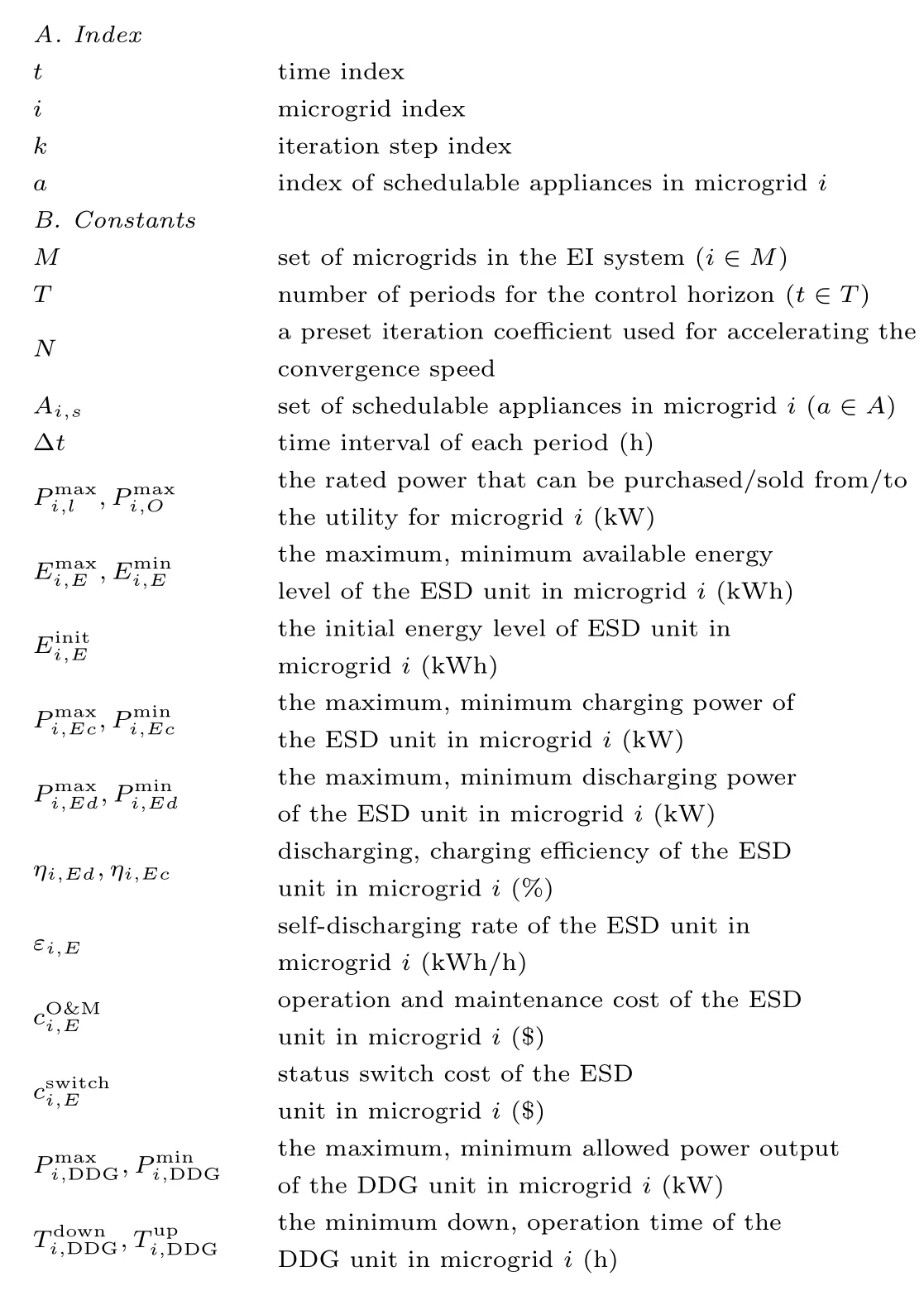
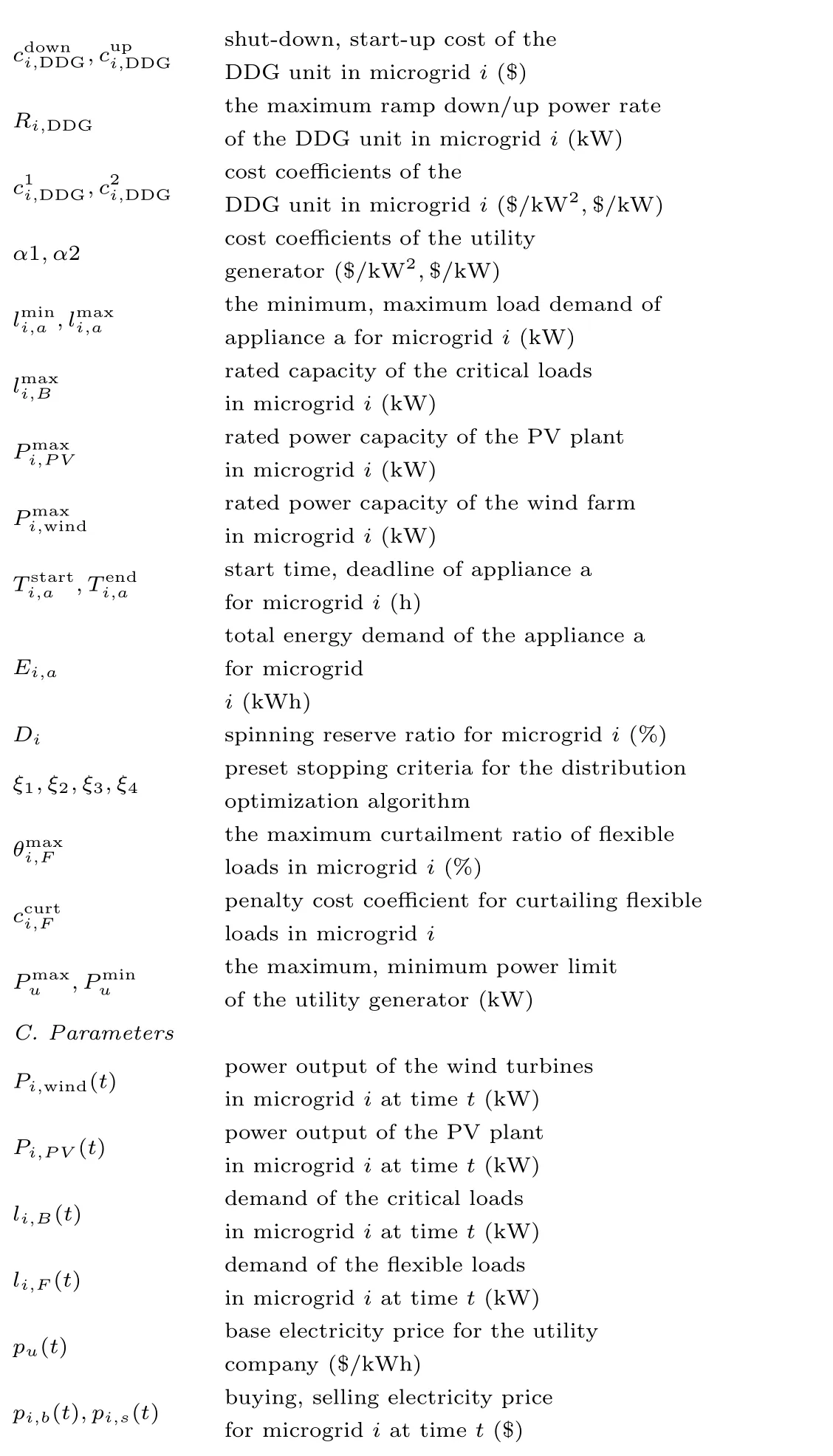
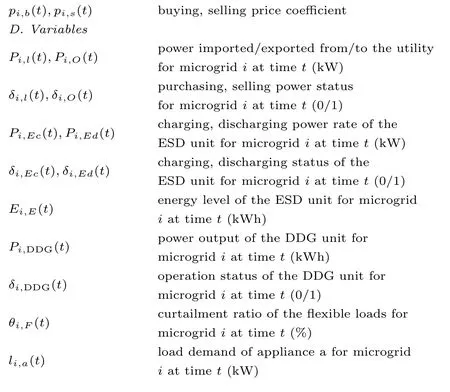
1 Introduction
The energy internet(EI)is an interesting concept for integrating more distributed energy resources,improving power quality and reliability,and reducing greenhouse gas emissions[1]?[3].This grid includes advanced digital meters,distribution automation,communication systems and distributed energy resources[4]?[7].Since more kinds and amounts of devices are integrated and much more data are needed to be collected and analyzed,the optimization and scheduling of the energy Internet(EI)becomes more complex than the traditional power system.To manage and operate such a complex infrastructure efficiently and reliably,a unit of the grid,known as microgrid(or energy local network)[8],[9],has been emerged as a promising platform for the EI to integrate and coordinate a large number of distributed energy resources in a decentralized way[10],[11].
A microgrid or an energy local network is a relatively small-scale localized power system that can distribute generation and load demand in a small geographic area more fl exibly and reliably.It typically includes a cluster of dispatchable distributed generators(DDGs)such as microturbines and diesel generators,non-dispatchable renewable energy resources(RERs)such as wind turbines and photovoltaic panels,energy storage devices(ESDs)such as battery storage,various types of smart loads such as heating,ventilating,air conditioning and washing machine,and some other onsite electric components[12].It can be operated in either grid connected mode or in islanded mode when there are external faults or to gain economic advantages.
As an important element of the EI,many studies have been made in the literature on the energy management of the microgrid.Albadi and Saadany[13]present a summary of demand response in deregulated electricity markets and some utilities’experiences with di ff erent demand response programs are discussed.Chia et al.[14]discuss the demand response management with multiple utility companies,and a two-level non-cooperative game model is proposed to express the interaction between utility companies and residential users.Su and Wang[15]review the energy management systems(EMSs)in microgrid operation.Chen et al.[16]propose an model predictive control(MPC)-based load scheduling approach for a home microgrid which considers electricity price uncertainties.Parisio et al.[17]provide a comprehensive model of microgrid and an MPC-based approach to efficiently optimize microgrid operation with considering time-varying requests and operation constraints.Zhu and Hug[18]present a stochastic approach to optimally dispatch the power of a microgrid.Su et al.[19]propose an MPC-based power dispatch approach with considering plug-in electric vehicles.
Due to the EI can be considered as the Smart Grid 2.0[20],the advanced technologies can be utilized for the future EI system.Tang et al.[21]?[23]propose a goal representation adaptive dynamic programming(GRADP)method to control and operate a smart grid.Amini et al[24]investigate two decomposition methods for solving the optimization problem in security constrained economic dispatch(SCED)of the power system.The advantages and drawbacks of each method are discussed in terms of accuracy and information privacy.Deng et al.[25]discuss a MPC based bilinear model to obtain optimal set-points to satisfy the campus cooling demands and minimize the daily electricity cost for a campus central plant which is equipped with a bank of multiple electrical chillers and a thermal energy storage.
Furthermore,the coordinated control of the microgrids,independent consumers and utility companies in an EI system can be considered as one of the most key problem of developing EI technology and it is the main topic of this paper.Huber et al.[26]investigate the bene fi ts of a community home microgrids and the coordination of smart homes.Olivares et al.[27]propose an MPC based approach to optimally dispatch the energy storage units,controllable generators and smart loads in medium-voltage isolated microgrids.Zhou et al.[28]describe the operation of a central controller for microgrids on neighboring islands to dynamically dispatch the production of local distributed energy resources.Ai and Xu[29]propose a centralized co-operation model for a smart distribution system which includes multimicrogrids.However,the above studies all are centralized approaches,heavy communication and computation burden will be yielded with the expanding of the system structure.In addition,these approaches cannot deal with the case that the microgrids have competitive objectives,they only aim to minimize the total operation cost of the whole EI system,but do not consider the distinct objectives of the individual microgrid.
Distributed control strategies could reduce the requirements to manipulate large quantities of information exchanges related to the complex network of microgrids.Fathi and Bevrani[30]study the energy consumption scheduling of connected microgrids with considering uncertainties in a semi-distributed approach.Wang et al.[31]present a stochastic bi-level based decentralized power dispatch model for the coordinated operation of multiple microgrids where uncertainties of RERs outputs are considered.Kamyab et al.[32]analyze the demand response problem in a smart grid with multiple utility companies and multiple customers.Two non-cooperative games:the supplier and customer side games developed,the existence and uniqueness of the Nash equilibrium in the mentioned games are studied.Asimakopoulou et al. [33]present a leader-follower strategy for analyzing competitive situations of hierarchical decision making between microgrids and large central production unit.A stackel-berg game is implemented to decide the real-time power exchange.Yang et al.[34]study a parallel distributed framework for demand response in smart grids which includes users withRERs.The goal is to optimize the load schedule of users to minimize the utility company’s cost and user payments.
Several factors,such as the power production of the RERs and load demand varying over the time,and the di ff erent microgrids having distinct objectives,make the traditional scheduling strategies unable to deal with the scheduling problems of EI efficiently.MPC is an advanced method for process control,which has been widely used in a variety of complex dynamic systems[35].In recent years,MPC has drawn much attention of the energy management community due to its ability to incorporate both forecasts and newly updated information to decide the future behaviors of the system and handle constraints efficiently.As the emerging of smart grid and EI technologies,the MPC-based distributed algorithms are also considered as a promising way to efficiently handle the cooperation problems of the large power system which consisted with multiple subsystems,due to it can not only keep the advantage of MPC technology but also can decompose the complexity of the optimization problem with a distributed way[36].
In this paper,we propose a MPC-based distributed optimal scheduling strategy for an EI which includes a utility company,multiple microgrids and a few independent consumers.This strategy is used for the coordinated operation of entities such as microgrids,utility and consumers,which have distinct objectives.All the microgrids and independent consumers are autonomously scheduled by their own EMSs.The EMSs send their total purchasing/selling plans to the EI operator and receive the real-time retail electricity price from the EI operator in each optimization iteration,which can e ff ectively reduce the computation burden comparing to the centralized optimization approaches,as well as avoid infringing the privacies due to each EMS does not need to disclose the operation plan of the dispatchable units to other EMSs.In addition,this strategy can save much communication costs and time comparing to the sequential distributed approaches used in[37].
More specially,the contribution of the present paper is summarized in the following:
1)A MIP-based optimization model of the microgrid which considers many key features,such as minimum running/stopping time of the DDGs,charging/discharging switch of the ESDs,and various kinds of smart loads is proposed.
2)MPC-based distributed optimization strategy which not only can coordinate the operation of entities in the EI system with competitive objectives but also can e ff ectively handle the uncertainties introduced by loads and RERs.
3)The proposed method is veri fi ed by simulation-based case studies.
The rest of this paper is organized as follows.Section 2 presents the model of the entities in the EI and the retail electricity price mechanism.Section 3 introduces the MPC based distributed control scheme for coordinating the operation of the entities in the EI.Case studies and simulations are implemented in Section 4.Finally,conclusions are drawn in Section 5.
2 System Model and Problem Formulation
Consider an EI consists of a set of microgrids,several independent consumers and a utility company,interconnected through a power transmission infrastructure and a communication network,as shown in Fig.1.For saving space and better understanding,we also consider the independent consumers as microgrids which have neither generators nor ESDs.The demand of each microgrid can be supplied from the internal sources(such as its own RERs,DDG,and ESD)or/and from the other sources(such as other microgrids and the utility company)throughout the EI system.The EI operator controls the generation output of the utility company,decides the retail selling/purchasing electricity price and sends this price information to all the microgrids,and receives information from the microgrids.The microgrid EMS controls the load schedule of the smart loads,the output of its own DDGs,the charging/discharging plan of its own ESDs,and the purchasing or selling power plan of the microgrid.The determination of the EI operator is in fl uenced by the actions of the EMSs,and vice versa.The objective of the EMS in each entity is to optimize its individual objective and to increase its own bene fi t,and the variables of each entity are distinct.Therefore,the coordination of the EI system can be formulated as competitive games model.
2.1 System Modeling
1)Loads Model
The loads in microgrid i consist of the critical loads,
schedulable loads,and fl exible loads[34],as shown in(1).

For the schedulable appliance α,there are start time and deadline constraints for completing its task,and the lower and upper power bounds should be satis fi ed during its operation time,as shown in(2).In addition,a certain energy must be consumed for this task,as shown in(3).

For the fl exible loads,the power adjustment ratio must be bounded in a certain range to keep the user’s comfort,as expressed in(4).

As we all know,the critical loads cannot be adjusted or scheduled,their power demand should be satis fi ed all the time.However,their actual and forecasted power demand both cannot excess the corresponding capacity limit,as denoted in(5).

2)Generators Model
In this EI,the microgrids may have DDGs and RERs.The DDG model used in this paper is based on a microturbine[17].Its power output,minimum up time,minimum down time,and ramp up/down power constraints are illustrated in(6)?(9),respectively.

where τ1,τ2are introduced auxiliary parameters,and τ1=t+1,...,min,τ2=t+1,...,min(t+,and they are used for expressing the minimum up and down time constraints,respectively.
Though the output of the RERs is considered as nondispatchable,for preventing large errors introduced by forecast models,the forecasted outputs of PV and wind generators must be in certain bounds in each period,as shown in(10)and(11).

3)ESD Unit Model
ESD units play an important role in the power system operation,control and management[38].ESD unit model in this paper is based on battery storage technology.It is modeled by the maximum and minimum state of charge(SOC)level,charging power limit,discharging power limit,and operation status,as shown in(12)?(15),respectively.In addition,the dynamic model of the ESD unit is very important,the SOC level at the beginning of the next period is determined by the current period SOC level and the charging or discharging operation during this period,as expressed in(16).
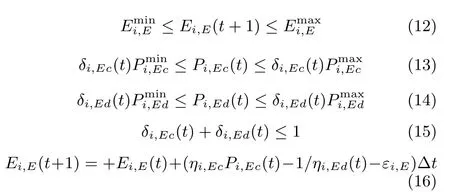
4)Interaction With Other Microgrids
When a microgrid operates in grid-connected mode,it can purchase/sell electricity from/to the utility company.For encouraging the local use of RERs power output,guaranteeing the bene fi ts of microgrid owners,and inciting the utility company to buy electricity from the microgrid,weset the electricity purchasing price and selling price di ff erent at the same time.The detailed price mechanism will be introduced in the following.Therefore,for more e ff ectively operating the microgrids,we introduce auxiliary variables δi,l(t)and δi,O(t)to model the possibility either to purchase from or to sell energy to the utility grid.The constraints of the purchasing power,selling power and operation status at the point of common coupling(PCC)for microgrid i can be illustrated as(17)?(19),respectively.

5)Power Balance Constraint
For each microgrid,power balance constraint must be satis fi ed in every period,as shown in(20).

Meanwhile,for the whole EI,the total generated power of the utility company plus the buyback power from all the microgrids must equal to the total power purchased by the microgrids.

Besides,the generators of utility should be operated in their power limit.

For reducing the negative impacts introduced by randomness of the RERs outputs and the loads demands,extra spinning reserve constraints must be considered for the EI system.
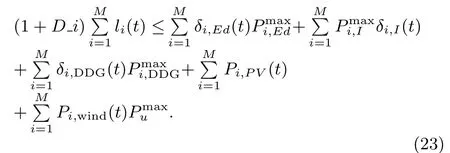
6)Retail Electricity Price Mechanism
The fuel cost of the utility generators and the DDGs are all non-decreasing convex function of their own generation.In most conditions,this convex function can be expressed as a quadratic function in(24).

Therefore,the basic electricity price of the utility can be denoted as follows:

Based on the overall consideration of increasing onsite RERs use,inciting the utility to buy electricity from the microgrids and the rate-of-return regulations[39],we set the retail buying and selling electricity price for the microgrids as(26)and(27),respectively.


where pi,b(t)>1 to guarantee the rate-of-return of the utility company,and ?< ρi,s(t)≤1 to incite the EI operator to buy the surplus energy of the microgrids and guarantee the user’s bene fi ts. ? is a preset coefficient.
2.2 Cost Modeling
For microgrid i,the objective is to minimize the total operation cost in the future hours,which includes:the operation cost of the DDG units and ESD units,the purchasing electricity cost by importing power from the utility company,the revenue from electricity sold back to the utility company.Due to the capital costs of the power devices are independent of the schedule,we do not consider them.Therefore,the total operation cost of microgrid i in the future hours based on the forecasts can be generated as follows(denoted as Ψi).

In(28),the fi rst term is the revenue of selling power back to the utility;the second term is the cost of purchasing energy from the utility;the third term denotes the operation costs of the DDG units,which include fuel consuming cost,startup cost,and shut down cost;the fourth term is the operation cost of ESDs,which comprises operation and maintenance cost,charge-to-discharge switch cost,and discharge-to-charge switch cost;the last term is the fl exible power curtailment penalty cost.
The total cost of the utility includes fuel consuming cost and purchasing cost from all microgrids(denoted as Ψu).

In(29),the fi rst term is the fuel cost of the utility and the second term is the purchasing electricity cost from all microgrids.
The objective of the ith microgrid is to minimize its total operation cost Ψiin the future hours by optimizing the dispatchable units in it.The goal of the utility would be to minimize its total cost Ψu.In practice,the schedules of each microgrid are calculated by trade-o ffbetween the retail purchasing/selling electricity and its total cost,furthermore,the decisions of each microgrid are a ff ected by the other microgrids.Therefore,it is intractable to minimize the total cost of the whole EI system with respect to the objective of each individual microgrid and the utility company in a centralized way.The reasonable way is to allow each microgrid to optimize its own operation schedules based on its EMS in a competitive way.
3 MPC Based Distributed Optimization
During the recent years,MPC framework has attracted many considerations in power system energy management due to the following reasons[25],[39],[40]:1)the control action is based on the forecasts of the future time and the newly updated information;2)a feedback and rolling horizon mechanism is implemented to make the system can adjust the control actions according to the varying information,this mechanism can handle stochastic factor effectively;and 3)it can efficiently handle di ff erent kinds of constraints,linear or nonlinear.Since the scheduling of the EI system is mainly completed by coordinating the operation of microgrids which has competitive objectives,a MPC-based distributed optimization strategy should be proposed.
The coordination procedures for MPC-based distributed optimization for an EI are as follows:
1)At the end of time step t?1,the EMS of microgrid i obtains the updated system state of all the components in this microgrid,including:SOC level of the ESD unit Ei,E(t),power output Pi,DDG(t)and operation status δi,DDG(t)of the DDG unit,the curtailed fl exible load li,F(t)θi,F(t),and the control action of the schedulable load li,a(t).Then the EMS calculates the forecasted data of the load demand,PV generation and wind production from t to t+T.
2)The microgrids obtain their optimal control sequence by solving(30)independently and parallel with Algorithm 2 shown in Table I in iteration k(k>0)and receive the newly updated retail electricity pricein iteration k+1 until the equilibrium among the microgrids have reached.
3)At time step t,only the fi rst element of the optimal control sequences of the dispatchable units in each microgrid obtained in step 2)can be implemented,the insufficient power due to the forecast errors will be compensated by the fast responsive generators of the utility company,in the opposite case,the surplus power will be abandoned,and then the EI operator corrects and updates the parameters of the RERs output and load demand forecast model with the new data.
4)Implement from step 1)again.
For ensuring the parallel distributed optimization algorithm in Table I can achieve convergence,a penalty function(denoted as)in[41]is introduced to limit the power changes of all the dispatchable units between two steps.It aims to prevent the big changes of one dispatchable unit in two successive iterations by penalizing the distance between two iteration steps,as shown in(30).


In(31),the only information that the ith microgrid needs to determine is its optimal operation schedule is the retail electricity prices.It can protect the user’s privacy due to that the EMS does not need to report its detailed operation scheme to other microgrids.Moreover,the distributed optimization algorithm in Table I will stop when the changes of utility cost and power schedules of the microgrids are within the preset thresholds in consecutive two iterations.
Due to the performance of the distributed algorithm presented in Table I is heavily dependent on the value of,thus the choice ofshould re fl ect the impacts of the ith microgrid in the EI scheduling,and e ff ectively prevent large changes between two successive iteration steps.Based on this consideration,an adaptive penalty coefficientis proposed which is the trade-o ffbetween the step-size and the iteration number.

TABLE I ALGoRitHM FoR PARALLEL DistRiButED OptiMizAtioN MEtHoD FoR EI SystEM

Equation(32)indicates that a relatively little coefficientcan make the distributed optimization algorithm converge to a certain range in a few iterations steps,and as the iteration number becomes large enough(k≥N)a larger and larger coefficientis generated to constrict the step-size of two iterations steps to ensure convergence of the algorithm.

where α > 0 is a preset constant,is used to prevent emerging negative value because the microgrid may sell energy back to the utility company,and π is a step-size coeffi cient which is used to adjust the operation impacts of the microgrids in the EI system.As the amount of the penalty coefficientre fl ects the importance of the ith microgrid in the EI system,the exchanged powerbetween the microgrid and the utility is chosen.
4 Simulation and Results
4.1 General Setup
We consider an EI system with three microgrids,an independent consumer and a utility,as shown in Fig.1.Each microgrid includes a PV plant and kinds of smart loads,meanwhile,microgrid 2 has a DDG unit instead of the wind farm.
The rated power capacity of the PV plants and wind farms,the rated power can be exchanged between the microgrids and the utility,and the rated power capacity of the critical loads are all listed in Table II,as shown in Fig.2.The prediction error probabilistic distributions of the load,wind and PV can be estimated with the method described in[42]?[45].However,as the focus of this paper is on the scheduling and operation strategies,simpli fi ed normal distribution models are used for representing the real-time forecast errors of them.Flexible load demand of EI system is assumed as 30%of the critical load demand at the same time,the maximum allowable curtailment ratio of it is 0.5,and we assume 2.5 times of the base electricity price as a penalty cost coefficient for penalizing the power curtailment of the fl exible loads.Since the schedulable loads are consisted of a number of tasks,as shown in Table III,we do not consider the penalty cost.Parameters of the ESD units are denoted in Table IV,the depth of discharge(DoD)for all the ESD units are assumed 80%,and the initial SOC of each ESD unit is 50%.Parameters of the DDG unit in microgrid 2 and the generator of the utility company are shown in Table V.
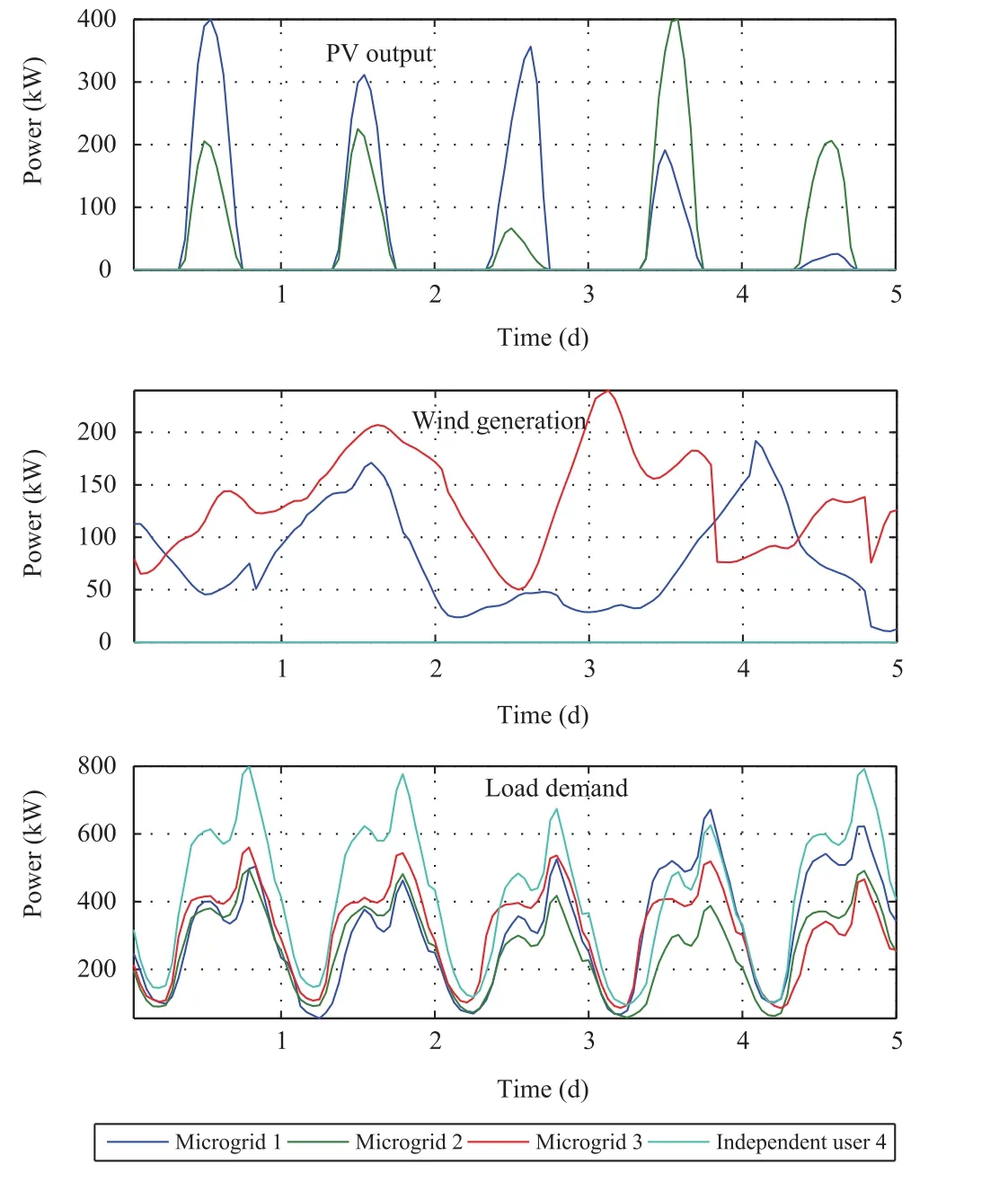
Fig.2. Data of the EI system needed in this paper.

TABLE II PowER LiMits oF MiCRoGRiDs AND INDEpENDENt UsER
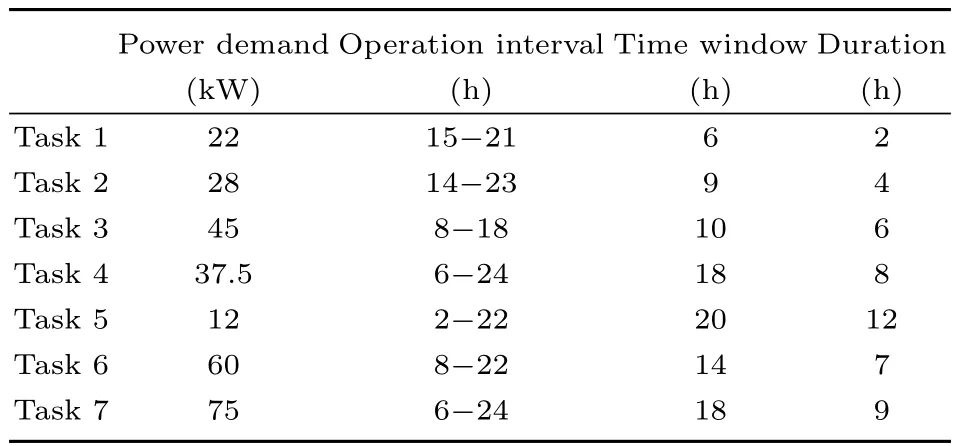
TABLE III PARAMEtER oF SCHEDuLABLE LoADs
The duration of one period is set as an hour,the prediction and control horizon equal to T time intervals,and the total simulation horizon is 5 days.Due to the rate-ofreturn regulations,we set the real-time retail purchasing electricity price for the microgrid as 1.2 times of the base price,and the real-time retail selling price for the microgridis 0.8 times of the base price.Due to the cost of the responsible generators which are operated in the real-time power compensation stage to guarantee the power balance of the EI system are higher than that of the common generators,for saving space and better understanding,we assume that cost coefficients of the responsible generators and the common generators are the same,but the electricity price for the responsible generators is 3 times of the base price.

TABLE IV PARAMEtER oF ESDs

TABLE V PARAMEtER oF CoNtRoLLABLE GENERAtoRs
The parameters of the stopping criteria for the distributed optimization algorithm in Table I is set to be

Theseaboveparametersareusedfordetermining whether the algorithm has reached its equilibrium.Other parameters used in this paper are set to be

4.2 Simulation Results
In this section we will fi rst verify the superiority of the MPC-based distributed(DMPC)strategy proposed in this paper by comparing its performance with the traditional day-ahead-based distributed(DDA)strategy with considering forecast errors,then we will discuss the impacts of the dispatchable elements such as the ESD units and DDG units in the microgrids’operation optimization,the impacts of the step-size coefficient π will be discussed at last.
All simulations were run on a PC with Intel(R)Core(TM)i5-3470 CPU@3.2GHz and 8.00GB memory.The ILOG’s CPLEX v.12 optimization solver is utilized for solving the MIP models,MATLAB 2013a and YALMIP toolbox[46]are used for linking the CPLEX solver and computing the optimization model.
4.2.1 Results of the DMPC Strategy and DDA Strategy
Firstly,we will introduce the DDA strategy brie fl y.It is an open-loop based algorithm[17],whose detailed process is shown as the follows.
1)In the scheduling stage,the EMSs implement the distributed optimization algorithm of Table I at the beginning of the day with the forecasted RERs production and load demand data and obtain the control sequence of the dispatchable units of all microgrids and the generation plan of the utility within this day.
2)In the real-time power compensation stage,all the microgrids will be operated as the control sequence determined in the scheduling stage strictly.The insufficient power will be compensated by the fast responsive generators of the utility,otherwise,the surplus power will be abandoned.
Figs.3 and 4 denote the operation schedules of the four microgrids by implementing the DMPC strategy and the DDA strategy,respectively without considering the realtime power compensation stage operation.
Microgrid 1 purchases 4.1696×104kWh electric power from the utility company,sells 100.447kWh electric power back to the utility company,charges 1.3842×103kWh electric power into the ESD unit,discharges 1.238×103kWh electric power from the ESD unit, and curtails 4.0911×103kWh load power demand in the fl exible loads with the DMPC strategy. There is 4.2804×104kWh electric power is purchased from the utility company,1.5318kWh electric power is sold back to the utility company,1.7663×103kWh electric power is charged into the ESD unit,1.607×103kWh electric power is discharged from the ESD unit,and 104.0521kWh load power demand is curtailed in the fl exible loads with the DDA strategy.The fi nal ESD energy level at the end of the simulation for DMPC strategy and DDA strategy are 169.457kWh and 144kWh,respectively.Though less power is purchased from the utility and more power is sold back to the utility with the DMPC strategy than the DDA strategy,the ESD unit plays a more important role with the DMPC strategy than the DDA strategy,moreover,much more fl exible power is curtailed with the DMPC strategy than the DDA strategy.Therefore,the operation cost of microgrid 1 with the DMPC strategy is higher than the DDA strategy,as shown in Table VI.
Microgrid 2 purchases 3.4277×104kWh electric powerfrom the utility company,sells11.18 kWh electricpowerback totheutility company,charges 1.5522×103kWh electric power into the ESD unit,discharges 1.3915×103kWh electric power from the ESD unit,generates 1.0322×104kWh electric power from the DDG unit,and curtails 1.8871×103kWh load power demand in the fl exible loads with the DMPC strategy.There is 3.6445×104kWh electric power is purchased from the utility company,no electric power is sold back to the utility company,1.6582×103kWh electric power is charged into the ESD unit,1.5085×103kWh electric power is discharged from the ESD unit,8.4204×103kWh electric power is generated from the DDG unit,and no fl exible load is curtailed in the fl exible loads with the DDA strategy.The fi nal ESD energy level at the end of the simulation for DMPC strategy and DDA strategy are 157.4584kWh and 135kWh,respectively.The situation of microgrid 2 is similar to microgrid 1,though the DDG unit plays a more important role with the DMPC strategy than the DDA strategy,much more fl exible load is curtailed with the DMPC strategy than the DDA strategy,it leads the total operation cost with the DMPC strategy is higher than the DDA strategy.
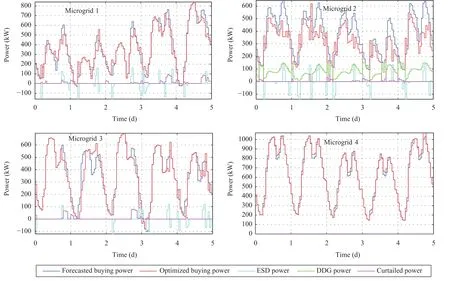
Fig.3.Operation schedules of the EI system for the DMPC approach.
Microgrid 3 purchases 4.2527×104kWh electric power from the utility company,sells 136.05kWh electric power back to the utility company,charges 0.8931×103kWh electric power into the ESD unit,discharges 0.8161×103kWh electric power from the ESD unit, and curtails 2.821×103kWh load power demand in the fl exible loads with the DMPC strategy. There is 4.3178×104kWh electric power is purchased from the utility company,98.3384kWh electric power is sold back to the utility company,1.3071×103kWh electric power is charged into the ESD unit,1.4371×103kWh electric power is discharged from the ESD unit,and no fl exible load is curtailed in the fl exible loads with the DDA strategy.The fi nal ESD energy level at the end of the simulation for DMPC strategy and DDA strategy both are 117 kWh.The situation of micro-grid 3 is similar to microgrid 1,and thus the total operation cost with the DMPC strategy is higher than the DDA strategy.
Microgrid 4 purchases 7.5811×104kWh and 7.5712 ×104kWh electric power from the utility company for the DMPC strategy and DDA strategy,respectively.No fl exible load is curtailed in the fl exible loads both with the DMPC strategy and DDA strategy.Therefore,the total operation costs of microgrid 4 with the DMPC strategy and DDA strategy are nearly the same.The reason the total operation costs with the DMPC strategy is a little higher than the DDA strategy is that the forecasts used for the DMPC strategy is updating as the time going,and is more accurate than those used for the DDA strategy.
Meanwhile,we also can evaluate the performance of the above operation strategies by analyzing the power output of the utility company under these strategies.There are 2.0627×105kWh and 1.9431×105kWh electric power generated by the utility without and with considering the DMPC optimization strategy,and 2.0636×105kWh and 1.9814×105kWh electric power generated by the utility without and with considering the DDA optimization strategy,respectively.The electric power generated by the utility without considering optimization strategies are di ff erent in two conditions just due to the forecast model in the DMPC strategy is updated all the time whereas it is no update in the DDA strategy.
As we all know,the forecasts of the RERs products and load demand are imperfect,therefore,the conclusions obtained from the above must be modi fi ed according to the actual data.The utility generation in the scheduling stage and the real-time stage with the DMPC strategy is nearly the same,only 263.09kWh electric power is generated by the fast responsive generators.However,the utility generation in the scheduling stage and the real-time stage with the DDA strategy has a little larger gap than that of the DMPC strategy,there is 5.051×103kWh electric power generated by the fast responsive generators,as shown in Fig.5.The similar conclusions can also be deduced from Table VI.Though the actual operation costs of the microgrids in the EI system is lower than the costs of condition that no optimization strategy is implemented,the cost increment of the DDA strategy from the scheduling stage to thereal-time stage is higher than that of the DMPC strategy.
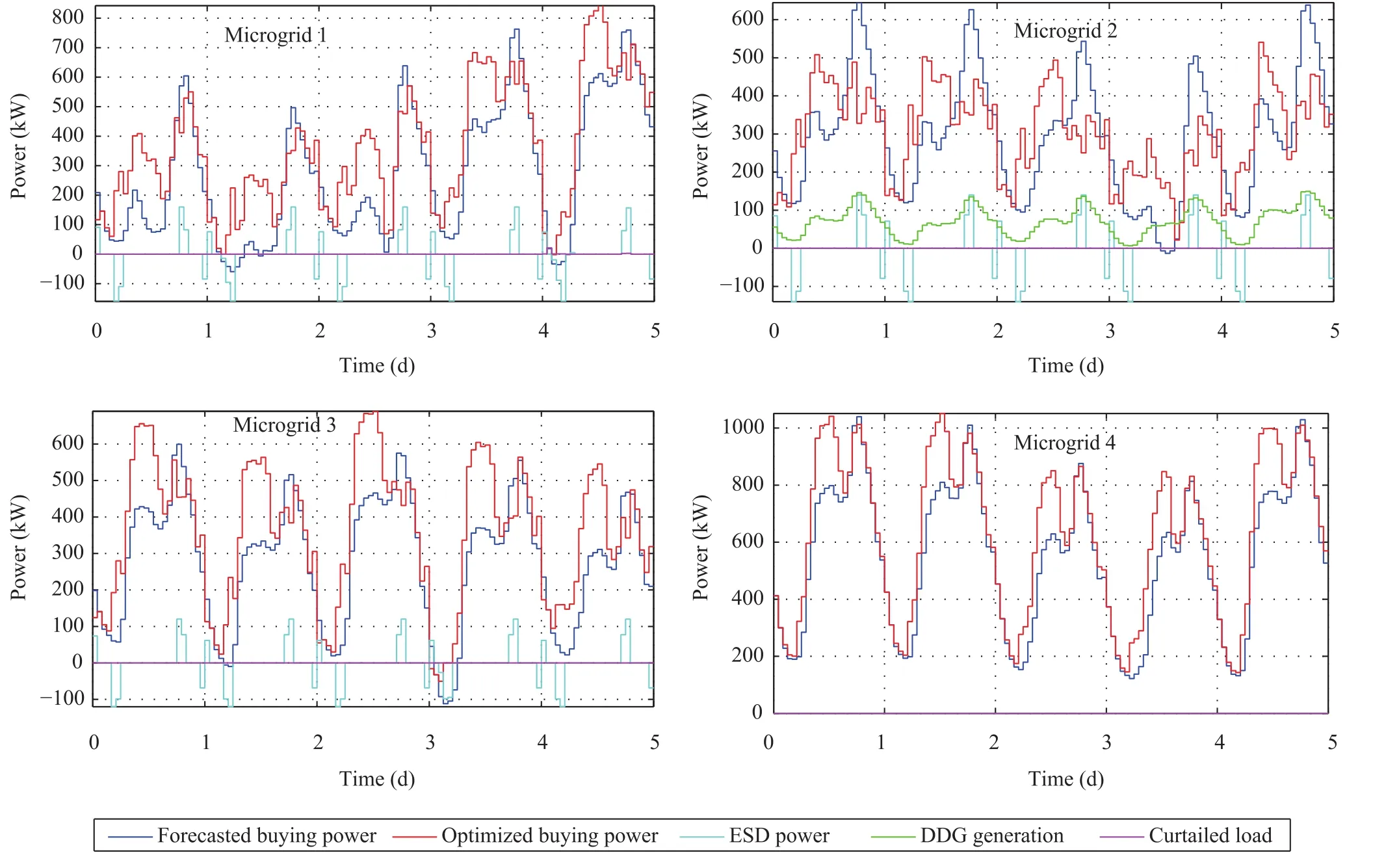
Fig.4.Operation schedules of the EI system for DDA approach.

Fig.5.Actual generation of the utility company with DDA approach and DMPC approach.
4.2.2 Discussions of Microgrid Elements
In this subsection we will discuss the impacts of the ESD units and DDG units in the EI system.
Without the aid of the ESD units,the microgrids have to sell the surplus power generated by the RERs back to the utility when the electricity price is low,and purchasemore power from the utility when the electricity price is high.The operation schedules of the microgrids without ESD units have large di ff erences from those of the microgrid with ESD units. The four microgrids purchase 4.2677×104kWh,3.4412×104kWh,4.3333×104kWh and 7.580×104kWh electric power from the utility company,respectively. Except microgrid 4(it has no ESD unit all the time),all the other microgrids increase the power purchased from the utility.They sell?100.1259kWh,0,?355.2156kWh,0 electric power back to the utility,re-spectively.The power sold from microgrid 3 increases a lot.In addition,without the ESD unit,the curtailed fl exible loads decrease a lot for all the microgrids.Meanwhile,due to the ESD unit is very small,the cost increment for all the microgrids is not very vast,as shown in Table VII.
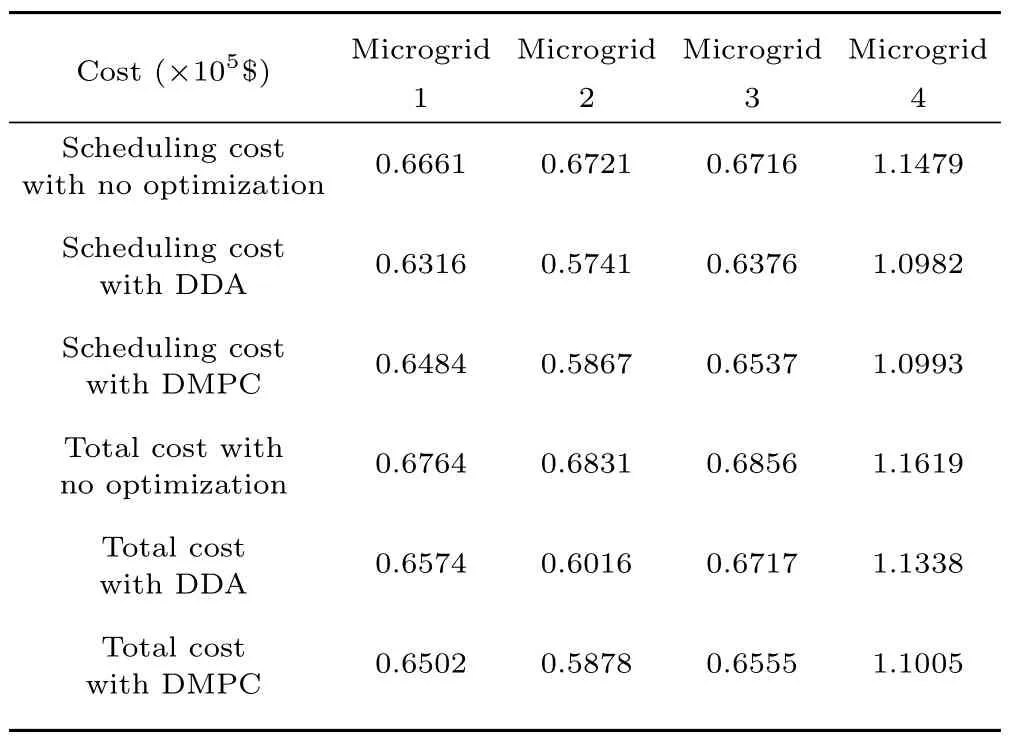
TABLE VI SCHEDuLiNG Costs AND tHE TotAL Costs FoR BotH DMPC AppRoACH AND DDA AppRoACH
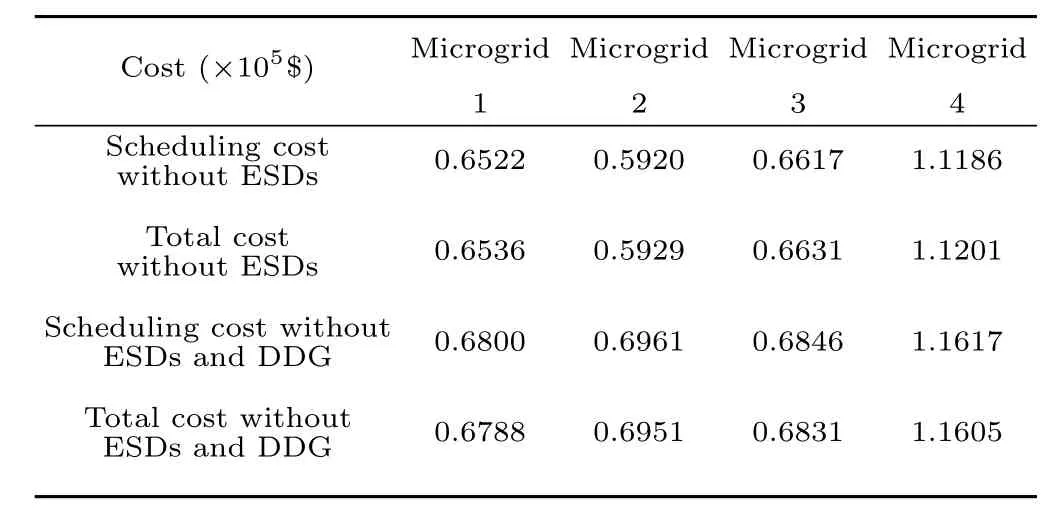
TABLE VII SCHEDuLiNG Costs AND TotAL Costs FoR DMPC AppRoACH WitHout SoME DispAtCHABLE ELEMENts
Though only microgrid 2 has a DDG unit,it also has signi fi cant impacts for the other microgrids’operations. The four microgrids purchase 4.2692×104kWh,4.4706×104kWh,4.3341×104kWh and 7.5806×104kWh electric power from the utility company,respectively.Only microgrid 2 purchases a large power from the utility,the total purchased power for the other microgrids is nearly the same asthe conditions of only without ESD units.Meanwhile,the sold power for all the microgrids are all the same as the conditions of only without ESD units.This simulation case fully illustrates that the microgrids in the EI system are coordinated with each other,though only the DDG unit in microgrid 2 is lost,the operation costs of all microgrids vary a lot.
4.2.3 Discussion of the Step-size Coefficient π
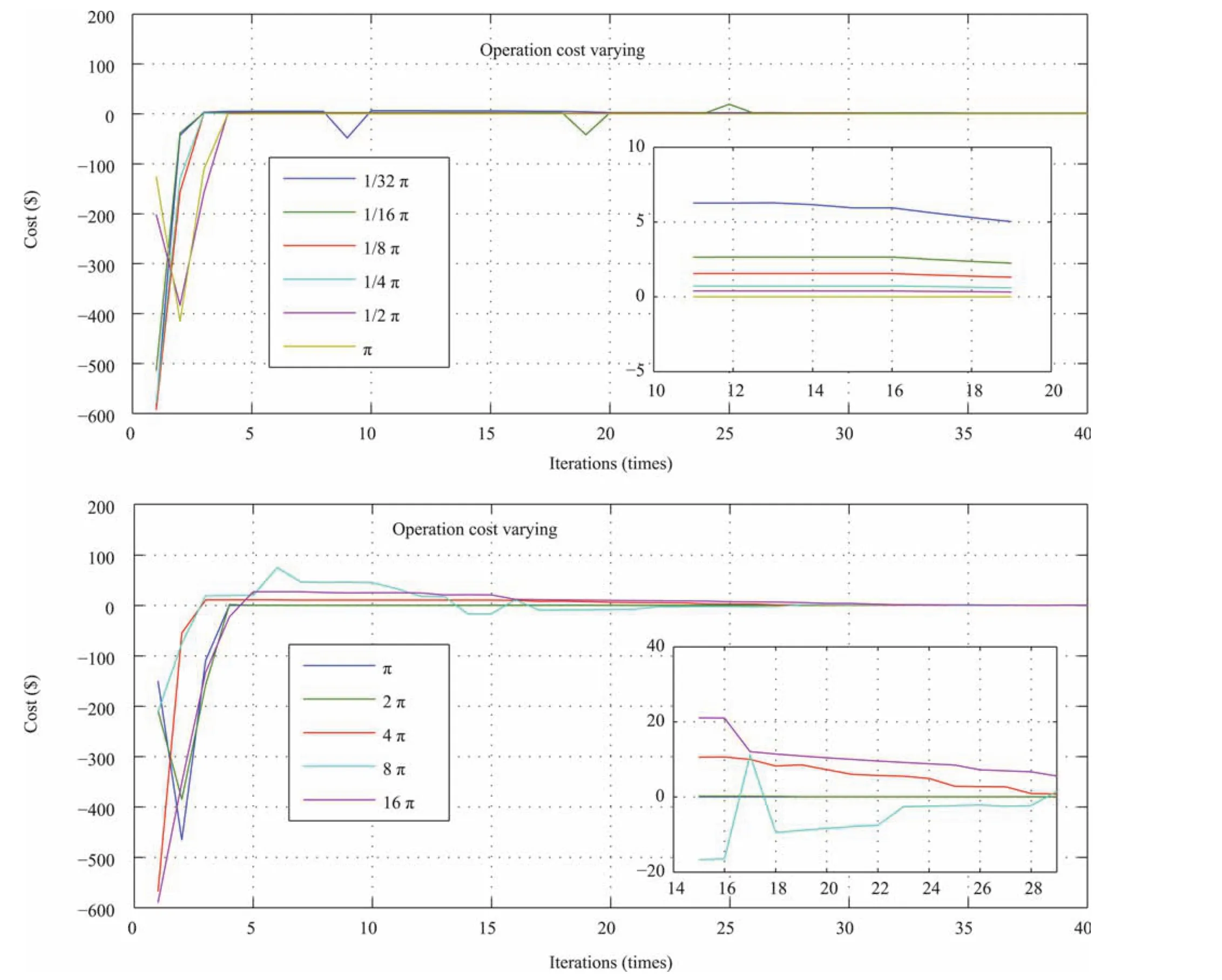
Fig.6. Convergence of the distributed optimization algorithm with di ff erent step-size coefficients.
We have brie fl y discussed the importance of the stepsize parameter for the convergence of the parallel distribution optimization algorithm in section III.In this section we will show a series of numerical simulations with di ff erent choice of this parameter,as shown in Fig.6.Weselect the base π=1 as used in(33)and then perform a series of simulations with the parameter πsimselected as 1/32π,1/16π,1/8π,1/4π,1/2π,π,2π,4π,8π,and 16π.We observe that for this four microgrids EI system,the convergence of the algorithm proposed in this paper can be achieved in as few as 5 iterations for the base π=1,and the number of iterations depends on the select value πsim.6 iteration needed to achieve convergence when πsim=1/4π.However,if πsimbecomes too small,the iteration numbers will increase sharply,22 iterations when πsim=1/8π,and more than 50 iterations are needed if πsim≤1/16π.
5 Conclusion
In this paper,we introduce a MPC-based parallel distributed optimization method for optimal operation of an EI which includes several microgrids,consumers,and a utility company.These microgrids are equipped with critical loads, fl exible loads,schedulable loads,wind turbines,PV panels,ESD units,and DDG units,and they are controlled and optimized by their own EMSs.EMS of a microgrid can determine the power purchasing and selling schedule between the microgrid and the utility,the operation plan of the DDG units,ESD units, fl exible loads and schedulable loads based on the electricity price information from the EI operator.In order to achieve the coordination of the microgrids and protect the user’privacies,a parallel distributed optimization is proposed,and a soft constraint on the EMS schedule change between two consecutive iterations is added.A traditional DDA strategy is implemented to evaluate the performance of proposed DMPC strategy.Numerical results showed that our proposed strategy is cost saving and robust.The total electricity bill for the microgrids is 2.994×105$for the DMPC strategy which is less than the 3.0645×105$for the DDA strategy and much less than 3.207×105$for the normal operation without any optimization.Moreover,the cost increments of the DMPC strategy are the lowest in the three methods when we consider forecast errors,as shown in Table I.The e ff ects of ESD units and DDG units on the DMPC strategy are investigated.Simulation results show that the dispatchable units can reduce the users’electricity bill e ff ectively,and the usage of these units in one microgrid can also a ff ect the operation schedule of other microgrids.The discussion of the step-size coefficient π shows that the step-size coeffi cient plays an important role for the convergence of the distributed optimization operation method,we can use a small coefficient at the beginning of iteration to accelerate the convergence speed,and use a large coefficient to guarantee the convergence of the distributed optimization method.
In our future work,we will focus on analyzing the EI system optimization operation method where the microgrids can determine the selling and purchasing energy prices,and theoretically analyze the convergence properties of the distributed optimization operation method.
1 H.Farhangi, “The path of the smart grid,” IEEE Power Energy Mag.,vol.8,no.1,pp.18?28,Jan?Feb.2010.
2 A.Q.Huang,M.L.Crow,G.T.Heydt,J.P.Zheng,and S.J.Dale,“Energy future renewable electric delivery and management(FREEDM)system:the energy internet,”P(pán)roc.IEEE,vol.99,no.1,pp.133?148,Jan.2011.
3 Y.B.Zha,T.Zhang,Z.Huang,Y.Zhang,B.L.Liu,and S.J.Huang, “Analysis of energy internet key technologies,”Sci.Sin.Inf.,vol.44,no.6,pp.702?713,Jan.2014.
4 D.Zhang,N.Shah,and L.G.Papageorgiou,“Efficient energy consumption and operation management in a smart building with microgrid,”Energy Convers.Manage.,vol.74,pp.209?222,Oct.2013.
5 J.Wu and X.H.Guan,“Coordinated multi-Microgrids optimal control algorithm for smart distribution management system,”IEEE Trans.Smart Grid,vol.4,no.4,pp.2174?2181,Dec.2013.
6 Z.Y.Dong,J.H.Zhao,F.S.Wen,and Y.S.Xue,“From smart grid to energy internet:basic concept and research framework,”Automat.Electric Power Syst.,vol.38,no.15,pp.1?11,Aug.2014.
7 T.Zhang,F.X.Zhang,and Y.Zhang,“Study on energy management system of energy internet,”P(pán)ower Syst.Technol.,vol.16,no.1,pp.146?155,Jan.2016.
8 R.H.Lasseter, “Smart distribution:coupled microgrids,”P(pán)roc.IEEE,vol.99,no.6,pp.1074?1082,Jun.2011.
9 N.Hatziargyriou,H.Asano,R.Iravani,and C.Marnay,“Microgrids,” IEEE Power Energy Mag.,vol.5,no.4,pp.78?94,Jul-Aug.2007.
10 J.Lee,J.Guo,J.K.Choi,and M.Zukerman,“Distributed energy trading in microgrids:a game-theoretic model and its equilibrium analysis,”IEEE Trans.Ind.Electron.,vol.62,no.6,pp.3524?3533,Jun.2015.
11 J.M.Guerrero,M.Chandorkar,T.L.Lee,and P.C.Loh,“Advanced control architectures for intelligent microgridsPart I:decentralized and hierarchical control,”IEEE Trans.Ind.Electron.,vol.60,no.4,pp.1254?1262,Apr.2013.
12 J.Silvente,G.M.Kopanos,E.N.Pistikopoulos,and A.Espu?na,“A rolling horizon optimization framework for the simultaneous energy supply and demand planning in microgrids,” Appl.Energy,vol.155,pp.485?501,Oct.2015.
13 M.H.Albadi and E.F.EL-Saadany,“A summary of demand response in electricity markets,”Electric Power Syst.Res.,vol.78,no.11,pp.1989?1996,Nov.2008.
14 B.Chai,J.M.Chen,Z.Y.Yang,and Y.Zhang,“Demand response management with multiple utility companies:a two-level game approach,”IEEE Trans.Smart Grid,vol.5,no.2,pp.722?731,Mar.2014.
15 W.C.Su and J.H.Wang,“Energy management systems in microgrid operations,”Electricity J.,vol.25,vol.8,pp.45?60,Oct.2012.
16 C.Chen,J.H.Wang,and Y.Heo,and S.Kishore,“MPC-based appliance scheduling for residential building energy management controller,”IEEE Trans.Smart Grid,vol.4,no.3,pp.1401?1410,Sep.2013.
17 A.Parisio,E.Rikos,and L.Glielmo,“A model predictive control approach to microgrid operation optimization,”IEEE Trans.Control Syst.Technol.,vol.22,no.5,pp.1813?1827,Sep.2014.
18 D.H.Zhu and G.Hug,“Decomposed stochastic model predictive control for optimal dispatch of storage and generation,”IEEE Trans.Smart Grid,vol.5,no.4,pp.2044?2053,Jul.2014.
19 W.C.Su,J.H.Wang,K.L.Zhang,and A.Q.Huang,“Model predictive control-based power dispatch for smart distribution system considering plug-in electric vehicle uncertainty,”Electric Power Syst.Resour.,vol.106,pp.29?35,Jan.2014.
20 J.W.Cao and M.B.Yang,“Energy internet-Towards Smart Grid 2.0,”in Proc.4th Int.Conf.Networking and Distributed Computing(ICNDC),Los Angeles,CA,USA,2013,pp.105?110.
21 Y.F.Tang,J.Yang,J.Yan,and H.B.He,“Intelligent load frequency controller using GrADP for island smart grid with electric vehicles and renewable resources,”Neurocomputing,vol.170,pp.406?416,Dec.2015.
22 Y.F.Tang,H.B.He,Z.Ni,J.Y.Wen,and T.W.Huang,“Adaptive modulation for DFIG and STATCOM with highvoltage direct current transmission,”IEEE Trans.Neural Networks Learn.Syst.,vol.27,no.8,pp.1762?1772,Aug.2016.
23 Y.F.Tang,H.B.He,Z.Ni,X.N.Zong,D.B.Zhao,and X.Xu,“Fuzzy-based goal representation adaptive dynamic programming,”IEEE Trans.Fuzzy Syst.,to be published.
24 M.H.Amini,R.Jaddivada,S.Mishra,and O.Karabasoglu,“Distributed security constrained economic dispatch,” in Proc.IEEE Innovative Smart Grid Technologies—Asia(ISGT ASIA),Bangkok,Thailand,2015.
25 K.Deng,Y.Sun,S.S.Li,Y.Lu,J.Brouwer,P.G.Mehta,M.C.Zhou,and A.Chakraborty,“Model predictive control of central chiller plant with thermal energy storage via dynamic programming and mixed-integer linear programming,”IEEE Trans.Automat.Sci.Eng.,vol.12,no.2,pp.565?579,Apr.2015.
26 M.Huber,F.Sanger,and T.Hamacher,“Coordinating smart homes in microgrids:a quanti fi cation of bene fi ts,”in Proc.2013 4th IEEE/PES Innovative Smart Grid Technologies Europe(ISGT Europe),Copenhagen,2013,pp.1?5.
27 D.E.Olivares,C.A.Ca?nizares,and M.Kazerani,“A centralized energy management system for isolated microgrids,”IEEE Trans.Smart Grid,vol.5,no.4,pp.1864?1875,Jul.2014.
28 Y.Z.Zhou,H.Wu,Y.N.Li,H.H.Xin,and Y.H.Song,“Dynamic dispatch of multi-microgrid for neighboring islands based on MCS-PSO algorithm,”Automat.Electric Power Syst.,vol.38,no.9,pp.204?210,May 2014.
29 X.Ai and J.J.Xu,“Study on the microgrid and distribution network co-operation model based on interactive scheduling,”P(pán)ower Syst.Prot.Control,vol.41,no.1,pp.143?149,Jan.2013.
30 M.Fathi and H.Bevrani,“Adaptive energy consumption scheduling for connected microgrids under demand uncertainty,”IEEE Trans.Power Deliv.,vol.28,no.3,pp.1576?1583,Jul.2013.
31 Z.Y.Wang,B.K.Chen,J.H.Wang,M.M.Begovic,and C.Chen,“Coordinated energy management of networked microgrids in distribution systems,”IEEE Trans.Smart Grid,vol.6,no.1,pp.45?53,Jan.2015.
32 F.Kamyab,M.Amini,S.Sheykhha,M.Hasanpour,and M.M.Jalali,“Demand response program in smart grid using supply function bidding mechanism,”IEEE Trans.Smart Grid,vol.7,no.3,pp.1277?1284,May 2016.
33 G.E.Asimakopoulou,A.L.Dimeas,and N.D.Hatziargyriou,“Leader-follower strategies for energy management of multi-microgrids,”IEEE Trans.Smart Grid,vol.4,no.4,pp.1909?1916,Dec.2013.
34 P.Yang,P.Chavali,E.Gilboa,and A.Nehorai,“Parallel load schedule optimization with renewable distributed generators in smart grids,”IEEE Trans.Smart Grid,vol.4,no.3,pp.1431?1441,Sep.2013.
35 Y.Zhang,T.Zhang,R.Wang,Y.J.Liu,and B.Guo,“Optimal operation of a smart residential microgrid based on model predictive control by considering uncertainties and storage impacts,” Solar Energy,vol.122,pp.1052?1065,Dec.2015.
36 E.Camponogara,D.Jia,B.H.Krogh,and S.Talukdar,“Distributed model predictive control,” IEEE Control Syst.,vol.22,no.1,pp.44?52,Feb.2002.
37 D.P.Bertsekas and J.N.Tsitsiklis,Parallel and Distributed Computation:Numerical Methods.Englewood Cli ff s,NJ,USA:Prentice-Hall,1989.
38 I.Prodan and E.Zio,“A model predictive control framework for reliable microgrid energy management,”Int.J.Electric.Power Energy Syst.,vol.61,pp.399?409,Oct.2014.
39 J.S.Netz,“Price regulation:A(non-technical)overview,”in Encyclopedia of Law and Economics,B.Bouckaert and G.De Geest,Eds,Cheltenham,Edward Elgar,2000,pp.1396?1465.
40 Y.X.Xu and C.Singh,“Power system reliability impact of energy storage integration with intelligent operation strategy,”IEEE Trans.Smart Grid,vol.5,no.2,pp.1129?1137,Mar.2014.
41 L.Y.Jia,Z.Yu,M.C.Murphy-Hoye,A.Pratt,E.G.Piccioli,and L.Tong,“Multi-scale stochastic optimization for home energy management,”in Proc.IEEE Int.Workshop on Computational Advances in Multi-Sensor Adaptive Processing,San Juan,Puerto Rico,2011.
42 ELIA,Belgiums electricity transmission system operator. Grid data, [EB/OL]. [Online]. Available:http://www.elia.be/en/grid-data
43 C.Yang and L.Xie,“A novel ARX-based multi-scale spatio-temporal solar power forecast model,”North American Power Symp.(NAPS),Champaign,IL,USA,2012,pp.1?6.
44 R.Hanna,J.Kleissl,A.Nottrott,and M.Ferry,“Energy dispatch schedule optimization for demand charge reduction using a photovoltaic-battery storage system with solar forecasting,” Solar Energy,no.103,pp.269?287,May 2014.
45 R.Blonbou,“Very short-term wind power forecasting with neural networks and adaptive Bayesian learning,”Renewable Energy,vol.36,no.3,pp.1118?1124,Mar.2011.
46 J.L¨ofberg, “YALMIP:a toolbox for modeling and optimization in MATLAB,”in 2004 IEEE Int.Symp.Computer Aided Control Systems Design,New Orleans,LA,2004,pp.284?289.
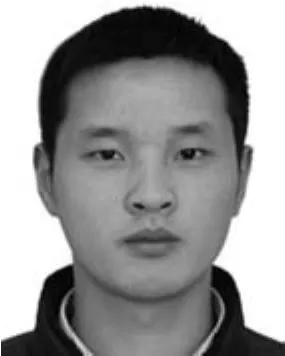

Tao Zhang received the B.S.,M.S.,PhD degree from the National University of Defense Technology(NUDT),China,in 1998,2001,and 2004,respectively. He is currently a Professor at the College of Information System and Management,the NUDT.His main research areas include multi-criteria decision making,optimal scheduling,data mining and optimization methods on energy internet network.E-mail:zhangtao@nudt.edu.cn

Rui Wang received the B.S.degree from the National University of Defense Technology(NUDT),China,in2008,and the Ph.D.degree from the University of Sheffield,U.K in 2013. He is currently a Lecturer at the NUDT.His main research areas include evolutionary computation,multi-objective optimization,machine learning,optimization methods on energy internet network. He wins the Operational Research Society Ph.D.prize Runners-up for the best Ph.D.dissertation 2016.E-mail:ruiwangnudt@gmail.com

Yajie Liu a Ph.D.and an Associate Professor in National University of Defense Technology.He was a visiting scholar at the Mechanical and Industrial Engineering Department of the University of Toronto from September 2008 to October 2009.His research interests include stochastic and robust optimization methods in energy management systems of microgird.
E-mail:energy_net@sohu.com
Bo Guo received the B.S.degree in Mathematics from Huazhong Institute of Technology,the M.S.degree in system engineering from NUDT and the Ph.D.degree in engineering management from Tokyo University of Science. Currently,he is the academic leader of Group of Management Science and Engineering,the principal of National Level Teaching Team in System Engineering and Management,a member of National Educational Guidance Committee for the Postgraduate of Engineering Management,and an assessor of International Project Management Professional.His research interests include system reliability,maintenance,supportability and safety. He has received 8 provincial-level scienti fi c and technological progress awards and 3 provincial-level teaching progress awards.He has published over 80 papers and 4 books including“Analysis of System Reliability” and “Project Risk Management”.
E-mail:guobo@nudt.edu.cn
Yan Zhang,Tao Zhang,Rui Wang,Yajie Liu,and Bo Guo.A model predictive control based distributed coordination of multi-microgrids in energy internet.Acta Automatica Sinica,2017,43(8):1443?1456
the B.S.degree from the Sichuan University(SCU),China,in 2010,and the Ph.D.degree from the National University of Defense Technology(NUDT),China in 2016.He is currently a Lecturer at the Science and Technology on Ship Integrated Power System Technology Laboratory,Naval University of Engineering.His main research areas include model predictive control,energy management and optimization,optimization methods on microgrid and energy internet.Corresponding author of this paper.E-mail:zy331214534@126.com
Manuscript
November 2,2015;accepted May 25,2016.
Recommended by Associate Editor Haibo He.
1.College of Information System and Management,National University of Defense Technology,Changsha 410073,China

